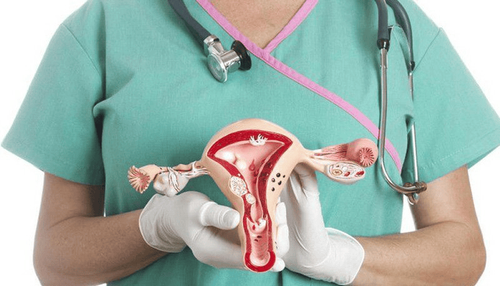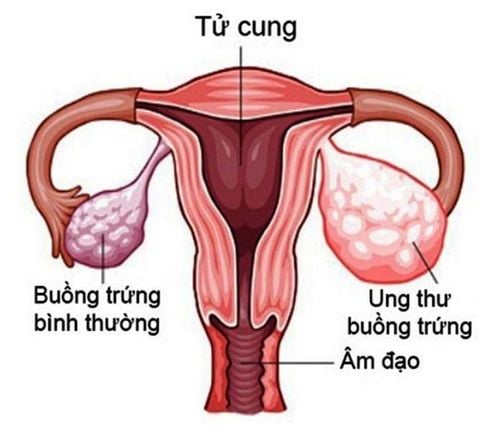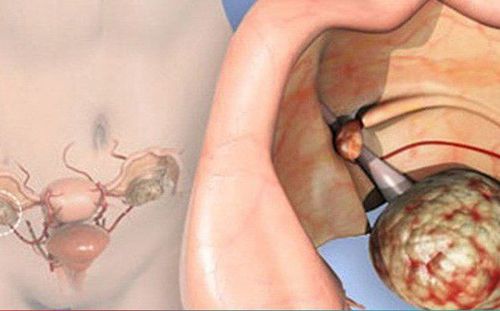This is an automatically translated article.
Ovarian cancer is a malignant tumor that originates in one or both ovaries. According to statistics, the incidence of ovarian cancer is about 4.6/100,000 women. The disease can occur at any age, but is most common in women over 50.1. What is ovarian cancer?
The ovaries are one of the female reproductive organs, each woman consists of 2 ovaries, they are located in the pelvis and are about the size of a seed. The function of the ovaries is to produce eggs, participate in fertilization and produce female hormones including estrogen and progesterone. Two types of hormones secreted by the ovaries have an impact on the development of a woman's body and are related to the menstrual cycle and pregnancy. Ovarian cancer is a malignant tumor that originates in one or both ovaries. Cancer cells are abnormal cells that grow out of the body's control and do not follow the body's needs. And these cancer cells can invade and destroy surrounding tissues and organs. Not only that, they can metastasize to distant organs in the body and cause secondary cancer in that organ.Types of ovarian cancer include:
Carcinoma of the ovary is cancer cells that develop from cells on the surface of the ovary, this is the most common type Germ cell cancer is a cancer that begins from egg-producing cells, this type is less common than carcinoma. Ovarian cancer begins in the tissue cells that support the ovary. This type is also rare
Trắc nghiệm: Bạn biết gì về các yếu tố nguy cơ, chẩn đoán và điều trị ung thư tuyến tụy?
Ung thư tuyến tụy phổ biến thứ 10 trong những bệnh ung thư mới và là nguyên nhân thứ 4 gây tử vong do ung thư ở nam, nữ. Bài trắc nghiệm này sẽ kiểm tra kiến thức của bạn về các yếu tố nguy cơ, chẩn đoán và cách điều trị ung thư tuyến tụy.
Bài viết tham khảo nguồn: medicalnewstoday 2019
2. Causes of ovarian cancer
The exact cause of ovarian cancer is still unknown. But studies show an association between the following factors that increase the risk of ovarian cancer:Family history : People who are related by blood such as mother, sister, and younger sister with ovarian cancer. Having a family history of breast cancer, colon cancer also increases the risk of ovarian cancer. Personal history: Women with a history of breast cancer and colon cancer have a higher risk of ovarian cancer Age: The likelihood of developing ovarian cancer increases with age, most appear in people over 50 years old and is higher in people over 60 years old. Pregnancy and childbirth: Women who have been pregnant and have given birth have a lower risk than those who have never given birth. The more children you have, the lower the risk. Use of ovulation-stimulating drugs: May slightly increase the risk of ovarian cancer. However, it is still under research. Hormone replacement therapy: Hormone replacement therapy after menopause increases the risk. Talc powder: Women who use talcum powder a lot in the genitals have an increased risk of ovarian cancer.

3. Signs to recognize ovarian cancer
Ovarian cancer, like most other cancers, has no early symptoms or signs, but it is not obvious until the late stage,However, early signs of the disease can be seen. These include:
Discomfort, pain in the lower abdomen Digestive disorders such as nausea, diarrhea or constipation Frequent urination due to increased pressure on the bladder Poor appetite, feeling of fullness even after a snack Unexplained weight gain or loss. Abnormal vaginal bleeding after menopause, irregular changes in the menstrual cycle. Pain during sex.

4. Stages of ovarian cancer development
Ovarian cancer develops through the following 4 stages:4.1 Stage 1 This stage the tumor is confined to the ovary or fallopian tube and has not spread to other organs.
1A cancer is in only one ovary or fallopian tube 1B cancer is already in both ovary or fallopian tube but not further away. 1C means the cancer is still inside the ovary or fallopian tube and has broken through the surface of the ovary to reach the outside. 4.2 Stage 2 In this stage the cancer has begun to spread to the organs in the pelvis.
2A can spread to the uterus or fallopian tubes 2B is when it has grown into other nearby organs such as the colon, bladder, or rectum.
5. The danger of ovarian cancer

If the disease is detected later, the survival rate is lower. Specifically, if detected in stage 2, the 5-year survival rate is about 70%, stage 3 is about 39%. If detected at the late stage, the survival rate is very low, the tumor has metastasized far, the ability to treat is difficult and the effectiveness is low.
Early detection and treatment of ovarian cancer brings efficiency and high survival chances for women. Do not be afraid to detect the disease because the earlier it is detected, the more effective the treatment. When there are any suspicious signs or in high-risk subjects, they should proactively go for early cancer screening.
At Vinmec International General Hospital, there is a package for screening and early detection of gynecological cancer. When registering the service package, customers are tested for gynecological function; Performing the necessary tests helps to detect cervical cancer and ovarian cancer early even when there are no symptoms.
When registering for Gynecological Cancer Screening and Early Detection Package, customers will receive:
Examination and consultation with a specialist in Obstetrics and Gynecology. Cervical cancer screening by tests such as cytology by Liqui Prep method, automated system HPV genotype PCR test, transvaginal ultrasound test of uterus and ovaries.
Please dial HOTLINE for more information or register for an appointment HERE. Download MyVinmec app to make appointments faster and to manage your bookings easily.













